IASbaba's Daily Current Affairs Analysis
Archives
(PRELIMS & MAINS Focus)
Syllabus
- Prelims – Geography and Economy
Context: The Embassy of Japan, New Delhi, has filed an application seeking a Geographical Indication (GI) tag for nihonshu/Japanese sake, an alcoholic beverage. This is the first time a product from Japan has filed for a tag at the Geographical Indication Registry in Chennai.
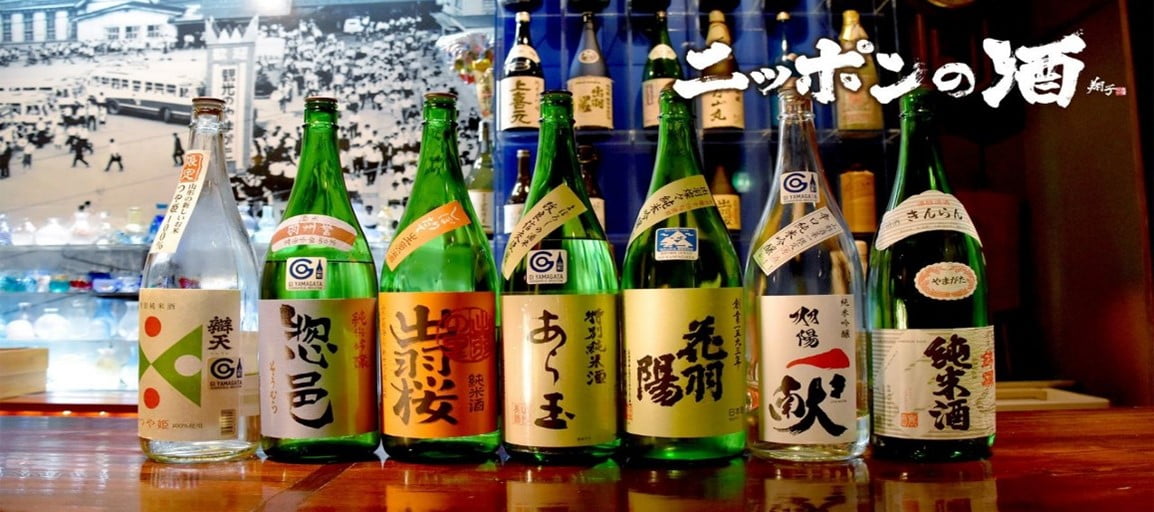
About Nihonshu:
- It is regarded as a special and valuable beverage made from fermenting rice.
- People traditionally drink nihonshu on special occasions, such as festivals, weddings or funerals, but it is also consumed on a daily basis.
- Thus, it is an integral part of the lifestyle and culture in Japan.
- The sake market (almost all are nihonshu) is the second largest brewed liquor (such as beer) market in Japan.
MUST READ: GI Tag and benefits
Source: The Hindu
Syllabus
- Prelims – Governance
Context: Recently the union minister for Railways recently launched India’s first all-aluminium freight rail rakes.
About Aluminum Freight Rake:
- Hindalco has developed these all-aluminium freight rail rakes.
- The Aluminum rakes have been developed to:
- Modernise freight transportation and
- Enable large carbon savings for Indian Railways.
- 61-wagon rakes have been flagged off from Bhubaneswar station.
Characteristics:
- The rakes are 180 tonnes lighter than existing steel rakes.
- They can carry 5-10% more payload.
- They consume less energy with relatively negligible wear and tear to rolling stock and rails.
Significance:
- Saving Carbon emissions:
- The bottom discharge aluminium freight wagon, specifically designed to carry coal, is tipped to reduce the carbon footprint measurably. These wagons save 14,500 tonnes of CO2 emissions.
- For every 100 kg weight reduction of the wagon, the lifetime CO2 saving is 8-10 tonnes. This translates to a saving of more than 14,500 tonnes of CO2 for a single rake.
- Other:
- These all-aluminium rakes offer 19% higher payload to tare weight ratio, which will have a transformative impact on the Railways’ logistics and operational efficiency.
- They consume less energy and are corrosion-resistant.
- They are 100% recyclable and even after 30 years, they will be as good as new.
- Boost for growth of sector:
- The freight sector in India is expected to grow at more than 7% CAGR to 15-billion tonnes by 2050, with the energy-efficient and eco-friendly Railways expected to notably increase its volume share from the current 18%.
Significance of using Aluminium:
- Aluminium trains command a lion’s share in the United States, Europe and Japan.
- This is because of its attributes such as sleek, aerodynamic designs.
- They also have an ability to tilt at high speeds without going off the rails.
- Aluminium is the preferred choice for metro trains worldwide for their durability and most importantly – passenger safety, as it has improved crashworthiness or superior crash absorption capability.
- Indian Railways have already announced their plans to make aluminium bodied Vande Bharat train sets.
Source: The Hindu
Syllabus
- Prelims – Science and Technology
Context: Recently, Dr. Dilip Mahalanabis, who was an Indian paediatrician known for pioneering the use of oral rehydration therapy to treat diarrheal diseases, passed away.
About Dr. Dilip Mahalanabis:
- Born on November 12, 1934 in West Bengal, he studied in Kolkata and London and later joined the Johns Hopkins University International Centre for Medical Research and Training in Kolkata in the 1960s, where he carried out research in oral rehydration therapy.
- When the 1971 war broke out, millions of people from then East Pakistan took refuge in India.
- Clean drinking water and sanitation were problems at these refugee camps, and cholera and diarrhoea broke out among people anyway exhausted and dehydrated.
- Dr Mahalanabis and his team were working in one such camp at Bongaon.
- In the mid-1980s and early 1990s, he was a medical officer in the Diarrheal Disease Control Programme of the WHO.
- Later in the 1990s, he served as the Director of Clinical Research at the International Centre for Diarrhoeal Disease Research (ICDDR,B), Bangladesh.
- In 1994, he was elected a foreign member of the Royal Swedish Academy of Sciences.
- In 2002, Dr. Mahalanabis was awarded the first Pollin Prize in Paediatric Research for their contributions to the discovery and implementation of oral rehydration therapy.
- In 2006, he was awarded the Prince Mahidol Prize, for his role in the development and application of oral rehydration therapy
Oral Rehydration Therapy:
- It is an alternative to intravenous rehydration therapy for preventing and treating dehydration from diarrhoea when intravenous therapy is not available or feasible.
- Oral rehydration therapy is calculated by the World Health Organization to have saved the lives of over 60 million persons.
Source: Indian Express
Syllabus
- Prelims – Art and Culture
In news: Prime Minister reviewed the construction of the National Maritime Heritage Complex (NMHC) site at Gujarat’s Lothal.
- The project began in 2022.
- It will have several innovative features such as Lothal mini-recreation, which will recreate Harappan architecture and lifestyle through immersive technology; four theme parks – Memorial theme park, Maritime and Navy theme park, Climate theme park, and Adventure and Amusement theme park.
- It will also house the world’s tallest lighthouse museum
- It will act as a centre for learning and understanding India’s maritime history and emerge as a world-class international tourist destination.
About Lothal:
- Lothal was one of the southernmost sites of the Indus Valley civilization, located in the Bhāl region of what is now the state of Gujarat.
- The meaning of Lothal (a combination of Loth and (s) thal) in Gujarati is “the mound of the dead”
- It is believed to have been built in 2,200 BC.
- Lothal was not only a major trading centre of the Indus Valley Civilisation, but it was also a symbol of India’s maritime power and prosperity. Its trade of beads, gems and ornaments reaching West Asia and Africa.
- Archaeologist SR Rao led the team which discovered Lothal.
- Lothal had the world’s earliest known dockyard, connecting the city to an ancient course of the Sabarmati river.
- A metropolis with an upper and a lower town had in on its northern side a basin with vertical wall, inlet and outlet channels which has been identified as a tidal dockyard.
- The National Institute of Oceanography in Goa discovered marine microfossils and salt, gypsum crystals at the site, indicating that sea water once filled the structure.
- The remains of stone anchors, marine shells, sealings which trace its source in the Persian Gulf, together with the structure identified as a warehouse further aid the comprehension of the functioning of the port.
- ASI unearthed a mound, a township, a marketplace, and the dock.
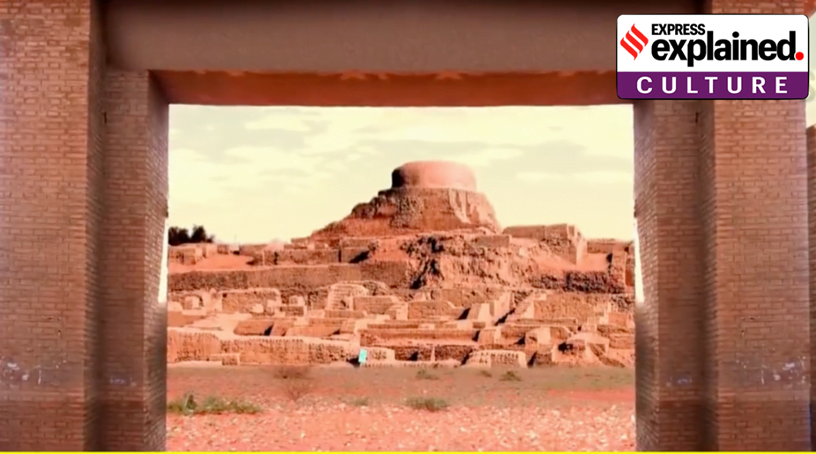
Significance:
- Lothal was nominated as a UNESCO World Heritage Site, and its application is pending on the tentative list of UNESCO.
- Lothal is the only port-town of the Indus Valley Civilisation.
- The river channel, now dried, would have brought in considerable volume of water during high tide, which would have filled the basin and facilitated sailing of boats upstream.
- Its heritage value is comparable to other ancient port-towns around the world – including Xel Ha (Peru), Ostia (Port of Rome) and Carthage (Port of Tunis) in Italy, Hepu in China, Canopus in Egypt, Gabel (Byblos of the Phoenicians), Jaffa in Israel, Ur in Mesopotamia, Hoi An in Vietnam, Balakot (Pakistan), Khirasa (in Gujarat’s Kutch) and Kuntasi (in Rajkot).
Source: Indian Express
Previous Year Question
Q.1) Which one of the following is not a Harappan site? (2019)
- Chanhudaro
- Kot Diji
- Sohgaura
- Desalpur
Syllabus
- Prelims – Environment
In news: Vehicle-mounted ‘anti-smog guns’ have begun their rounds in Delhi as air quality begins to take a turn for the worse.
- A Supreme Court order from 2020 mandated the use of anti-smog guns at large construction sites, road construction stretches and dust-prone traffic corridors.
- While only large construction sites of 20,000 sqm or more needed them last year, they have now been mandated by the Delhi government at smaller construction sites of 5,000 sqm or more.
About:
- In winter, conditions are dry and with repeated action on the top soil, dust gets lifted and is unable to settle due to low humidity.
- Anti-smog guns spray water in a fine mist to get suspended dust and particulate matter to settle.
- It uses water’s ability to remove pollutants called as wet scavenging.
- It is useful especially in emergency situations, where there is a fire or construction and demolition dust.
- CPCB’s guidelines on anti-smog guns: Water throw distance ranges from 30 metres to 100 metres depending on the device.
- Anti-smog guns can also be rotated.
- Treated waste water is not to be used in the anti-smog gun.
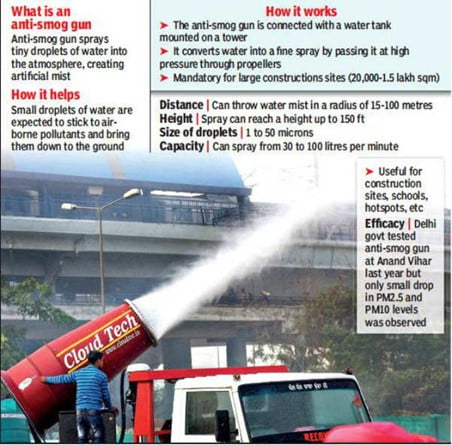
Concerns:
- There has been no thorough scientific analysis so far to determine what impact they have, and there could be some brief effect at best.
- Humidification may make the particles bigger and can lead to larger drops.
- It is not a permanent solution since water itself is an important resource. The guns use 40 to 250 litres of water per minute depending on the device.
Source: Indian Express
Previous Year Question
Q.1) Photochemical smog is a resultant of the reaction among (2013)
- NO2, O3 and peroxyacetyl nitrate in the presence of sunlight
- CO, O2 and peroxyacetyl nitrate in the presence of sunlight
- CO, CO2 and NO2 at low temperature
- High concentration of NO2, O3 and CO in the evening
Syllabus
- Prelims – Environment
In News: A recent genealogical study of the largest captive herd in India at the Alipore Zoological Garden in Kolkata has confirmed that these are most likely Nubian giraffes or the Rothschild giraffe.
- About 150 years ago, British colonialists brought northern giraffe to India.
- These now comprise a captive population of 29 individuals across the country.
About:
- Study aims to ensure that two different giraffes are not interbred with each other and the giraffes’ germplasm is preserved.
- “Stud-books” maintained in zoos across India had little to no information on where the giraffes brought to India from Africa had been captured, so the only way to identify the species would be through a mitochondrial gene study.
- As giraffes are an exotic species that was imported into India, protocols to manage the populations were different when compared to animals that are native to the country.
About Nubian giraffes:
- Nubian giraffes (or Giraffa camelopardalis camelopardalis) are believed to be among three sub-species of the northern giraffe.
- It is found in Ethiopia, Kenya, Uganda, South Sudan and Sudan.
- It is currently extinct in the wild of the Democratic Republic of Congo, Egypt and Eritrea.
- The Nubian giraffe used to be widespread in northeast Africa.
- IUCN status: ‘critically endangered’
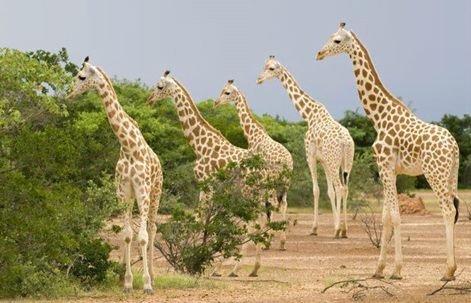
About Rothschild giraffe:
- Rothschild giraffe (or Giraffa camelopardalis Rothschild) is a subspecies of the Northern giraffe.
- The Rothschild’s giraffe is easily distinguishable from other subspecies. The most obvious sign is in the colouring of the coat or pelt.
- They live in savannahs, grasslands, and open woodlands of Uganda and Kenya.
- IUCN status: ‘endangered’
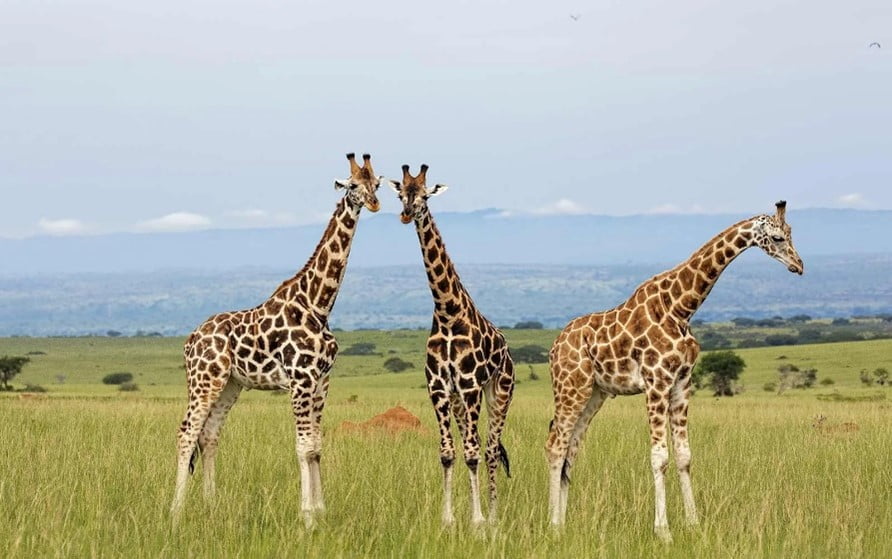
Source: The Hindu
Syllabus
- Mains – Economy
In News: The Commerce Ministry has once again deferred the launch of its new foreign trade policy (FTP) as it felt the need to have wider consultation with industry.
- The current FTP (from 2015-20 but extended thereafter till March 2023) is a policy document that spells out the objectives and strategies to boost exports.

New foreign trade policy (FTP):
- The current trade policy was introduced in 2015 for a five-year term.
- During the COVID-19 pandemic, the government extended the Foreign Trade Policy 2015-20 for till 2022-23.
- The new policy will be a comprehensive and important document that interprets rules, regulations, and procedures in international trade transactions, which are critical in facilitating in export-import operations and making the export sector more competitive.
- India’s strategy is to cash in on a world seeking to become less dependent on China and to enable exporters (and importers) to plan their investments ahead.
- The new policy will aim to provide a leg-up to exports and address some of industry’s key concerns, including a buffer against rising interest rates. It could include measures to help push up goods and services exports as well as rein in the runaway import bill.
- There is a need for new policy due to global growth slowdown and recession fears after the Ukraine-Russia war.
- The Indo-Pacific Economic Framework has led to assertions that the Government has ‘no bandwidth’ left for new free trade pact negotiations through more countries

Significance:
- Enhance trade facilitation measures
- Provide a simpler duty exemption scheme
- Reintroduce a services export promotion scheme
- Increase India’s share in global services exports
- Increase employment
- Boost domestic manufacturing
- Rope in India’s economic clout across the globe
- Leverage India’s potential in the services sector for greater export revenue
RoDTEP scheme & its issues:
- Remission of Duties and Taxes on Export Products (RoDTEP) scheme aims at neutralising the taxes at the State and local levels not otherwise refunded under any other mechanism.
- RoDTEP is a refund of duties and taxes (electricity duties, petroleum taxes, stamp duty etc.) which are embedded in manufactured products for exports. These taxes and duties are also applicable on excluded sectors and therefore need to be refunded to all sectors.
- However, this does not include “cess and levies,” which has emerged as a potent instrument in recent years, to collect funds for designated purposes.
- Not only this, the RoDTEP benefits are confined to limited sectors and a number of important sectors such as pharmaceuticals (chapter 30 of the FTP), chemicals (chapter 28 and 29) and steel (chapter 72 and 73) are out of its purview.
- Under the current policy, RoDTEP benefits are not available to advance authorisation holders and EOU’s.
- Exemption granted under the advance authorization/EPCG scheme/EOU is primarily from customs duties and IGST and not from embedded taxes like electricity duty, diesel/petrol taxes etc.
- Suggestion: The RoDTEP benefits needs to be extended to Advance Authorization holders and EOU’s on priority basis.
Other challenges:
- Pendencies:
- there is long list of pending cases of redemption with respect to Advance Authorization scheme due to pre-import conditions.
- This needs to be sorted out immediately by withdrawing the pre-import condition retrospectively.
- If this is not possible, examination of pre-import condition should be limited to the actual violation based on actual import with respect to export and should not be based on the licensing period.
Suggestions:
- Government should take into account the details of imports and against each authorisation on individual merits and help redeem such cases.
- To achieve the $1,000 billion exports target by 2030, it is important to resolve pending cases in a justified and time-bound manner.
- This will help exporters to focus on boosting exports rather than grappling with their existing cases.
- Manufacture and Other Operations in Customs Warehouse (MOOWR)
- Introduced in 2019 to facilitate duty free imports for exports under the Customs bonded warehouse.
- This scheme is akin to Export Oriented Units (EOU) of the FTP.
- Complicated methodology: Because the EOU scheme has dual monitoring, one by Development Commissioner and another by customs
- there are significant ambiguities on the scope of operations, depreciation provisions relating to capital goods etc., which need to be addressed for greater transparency
- Suggestions: it is better to bring about a simple methodology for conversion of existing units under EOU scheme into MOOWR scheme.
- Imports are subject to compliance with domestic laws as outlined in the FTP.
- It provides a generic guideline and actual regulations are multiple and not available at a single point.
- There is need to provide greater clarity and explanation of laws, rules, orders, regulations and technical specifications stipulated in Para 2.03 of the existing FTP.
- Suggestions: A separate appendix in the Handbook of Procedures covering all compliances under various domestic laws is required.
Way forward:
- The new FTP focusses more on addressing operational issues of EXIM operations as they reduce not only the cost of doing operations but also improves firm level export competitiveness.
- To enable a mechanism for integrated tax neutralisation through a single window.
- Lowering down logistics costs to make products competitive.
- Digitisation and e-commerce must integrate government policies such as one district one product and should complement each other.
- Free trade agreements between regional partners must be further explored for tapping trade opportunities with leading economies.
Source: The Hindu Businessline
Syllabus
- Mains – GS 1 Indian Society
In News: The death of two brothers due to drug addiction on the same day in Punjab’s Amritsar and a viral video of drug abuse inside a jail where one of the brothers was lodged has put the focus back on the drug menace in the state.
- This is the second such case of brothers dying due to alleged drug addiction in the Majha region in the last two months
Understanding the situation:
- Globally, the prevalence of alcohol use disorders is significantly higher than the prevalence of drug use disorders.
- Generally, alcohol and drug use disorders are more common among males than among females.
- According to the World Health Organisation Report 2002 (WHO), 8.9% of the total burden of disease is due to use of psychoactive substances; tobacco accounted for 4.1%, alcohol 4%, and illicit drugs 0.8% of the burden of disease.
- There are 2 billion alcohol users, 1.3 billion smokers and 185 million drug users globally (WHO 2002).
- These three psychoactive substances have different disease burden on different age groups.
- Illicit drug use causes mortality earliest in life, alcohol also mainly (65%) before the age of 60, while 70% of the tobacco deaths occur after the age of 60.
- The use of different substances varies in different WHO regions as in Europe and South-East Asia tobacco use is the largest burden while alcohol is the largest burden in Africa, the Americas, and Western Pacific.
- 155 to 250 million people, or 3.5% to 5.7% of world’s population aged 15-64 used other psychoactive substances, such as cannabis, amphetamines, cocaine, opioids, and non-prescribed psychoactive prescription medication (WHO-2008).
- Globally, cannabis is the most commonly used substance (129-190 million people), followed by amphetamine type stimulants, then cocaine and opioids.
Indian Context:
- In India, opioids are commonly used including heroin (‘smack’ / ‘brown sugar’) as well as pharmaceutical opioids (such as buprenorphine, pentazocine and dextro-propoxyphene).
- In the north-eastern region, heroin and dextropropoxyphene are the most commonly used opioids
- Impure heroin (smack), and buprenorphine are the most commonly used opioids in metropolitan cities such as Delhi, Mumbai, Chennai and Kolkata.
- Pentazocine is the most commonly injected opioid in Karnataka, Andhra Pradesh, Chattisgarh.
- In the states of Punjab and Haryana, buprenorphine is commonly used by injectors.
- As per the HIV sentinel surveillance report, HIV prevalence among IDUs in India is 7.2%. However, some states have much higher HIV rates among IDUs such as HIV prevalence among IDUs is 21% in Punjab, 18% in Delhi and around 12% in Manipur and Mizoram.
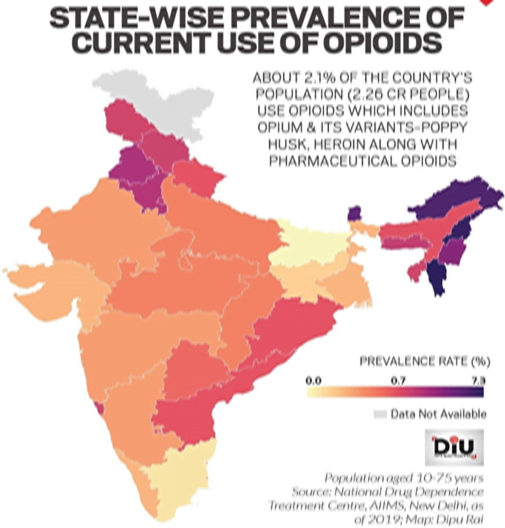
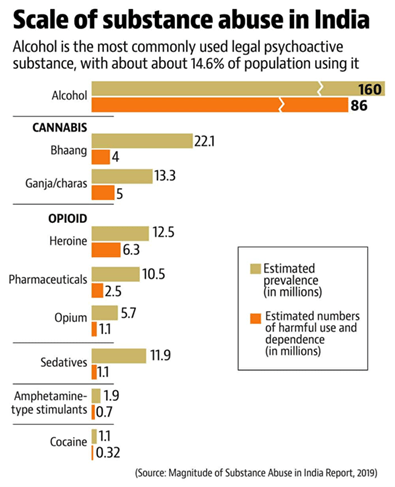
Causes:
- Genetics & Family History – Your genes may mean a greater predisposition to addiction. If your parents or their parents had a history with drug abuse, your chances of being addicted to drugs increase drastically.
- Environmental Cause – As environment influences behaviour, it can contribute to drug addiction
- Abuse of drugs among friends and peers
- Lack of social support
- Troubled relationships
- Stress in life
- Low socioeconomic status
- Psychological Cause such as sexual or physical abuse, negligence from parents and peers, domestic violence, everything can lead to psychological stress. And people turn to drugs to let off this stress. Over time, this misuse of drugs can become an addiction.
- Other psychological causes
- Mental disorder such as depression
- Lack of friends in school or any social setting
- Huge academic pressure
- Traumatic events
- Glorification in popular media like television series, films picturises it as a thrilling and seductive affair for youngsters who can be misguided easily because of their relative lack of experience in life.
- Lack of knowledge of risk factors related to drug abuse.
Concerns:
- People who inject drugs (psychoactive drugs for non-medical purposes) are at increased risk of HIV, hepatitis B and hepatitis C.
- Around 13 million people inject drugs globally and 1.7 million of them are living with HIV; injecting drug user accounts for approximately 10% of HIV infections.
- The estimated global prevalence of hepatitis C in people who inject drugs is 67%.
- Psychoactive substance use by drivers has been associated with impaired driving and increased accidents risk.
- Health and social problems associated with use of and dependence on tobacco, alcohol and illicit substances can be prevented by greater awareness by individuals, families and societies to use appropriate public health actions.
Suggestions:
- Knowledge and Education: learning about the physical, biological, and social effects of drug misuse and evaluating the risk factors like losing a job, isolation from society, dropping out of college.
- Developing a healthy lifestyle: There is no better prevention of drug problems than adopting a healthy lifestyle. Being active and fit makes it easier to manage stress. This, in turn, helps to reduce the urge to use drugs or any other harmful substances to manage stress.
- Behavioural Therapy: is the standard treatment for drug addiction after detoxification. It can be done by one-on-one sessions, in a group, or family basis, depending on the requirements.
- Learning healthy ways to cope with stress – Stress is one of the primary reasons that drive people to drug misuse. In this fast-paced world, stress is inevitable. Healthy habits like exercising, volunteering for a good cause, etc. to increase sense of fulfilment.
- Developing close bonds with family: A loving family works as a support system and helps you deal with your pressures in life.
Government initiatives:
- Nasha Mukt Bharat: Annual Action Plan (2020-21)
- three-pronged attack combining efforts of Narcotics Bureau, Outreach/Awareness by Social Justice and Treatment through the Health Dept.
- The Action Plan has the following components: Awareness generation programmes; Focus on Higher Educational institutions, University Campuses and Schools; Community outreach and identification of dependent population; Focus on Treatment facilities in Hospital settings; and Capacity Building Programmes for Service Provider.
- National Action Plan for Drug Demand Reduction for the period of 2018-25 prepared by The Ministry of Social Justice and empowerment
- Preventive education
- Awareness generation
- Identification, counselling, treatment and rehabilitation of drug dependent persons
- Training and capacity building of service providers through collaborative efforts of government and civil society
Way forward:
- Though the government has an over-encompassing blueprint, committed workforce and several dedicated programmes and policies at its disposal, there is a need to improve the current programmes (to address the unmet needs), to have a coordinated effort between Ministries, incurring uniformity at the policy level, to make scientifically informed choices and to strengthen the supply reduction chains.
Heroine:
- Heroin is an opioid drug made from morphine, a natural substance taken from the seed pod of the various opium poppy plants grown in Southeast and Southwest Asia, Mexico, and Colombia.
- Heroin can be a white or brown powder, or a black sticky substance known as black tar heroin.
- People inject, sniff, snort, or smoke heroin. Some people mix heroin with crack cocaine, a practice called speed balling.
- Heroin enters the brain rapidly and binds to opioid receptors on cells located in many areas, especially those involved in feelings of pain and pleasure and in controlling heart rate, sleeping, and breathing.
- People who use heroin report feeling a “rush” (a surge of pleasure, or euphoria)
- However, there are other common effects, including: heavy feeling in the arms and legs, nausea and vomiting, clouded mental functioning and being unconscious.
- Long term effects may include liver and kidney diseases, infection of the heart lining and valves, abscesses, mental disorders such as depression, etc.
Source: Indian Express
Syllabus
- Prelims – Economy
- Mains – GS 3 (Economy)
Context: The livestock sector is one of the most rapidly growing components of the rural economy of India, accounting for 5% of national income and 28% of agricultural GDP in 2018-19. In the last six years, the livestock sector grew at 7.9% (at constant prices) while crop farming grew by 2%.
Women and Livestock farming:
- The majority of women workers in rural areas (72%) are engaged in agricultural activities.
- There were five million women members in dairy co-operatives in 2015-16, and this increased further to 5.4 million in 2020-21.
- Women accounted for 31% of all members of dairy producer cooperatives in 2020-21.
- However, with the exception of participation in dairy co-operatives, specifically in milk marketing, women’s role in the livestock economy is not as widely known or discussed.
- 12 million rural women were workers in livestock-raising, an estimate based on the Employment and Unemployment Survey of 2011-12.
- However, with the augmented definition, we estimated that around 49 million rural women were engaged in livestock raising.
- Hence women actually engaged in the livestock economy were approximately four times the official estimate.
- Statistics from India’s first national Time Use Survey in 2019 shows that 11% of rural women or 48 million women were engaged in animal rearing.
- Data from village surveys conducted by the Foundation for Agrarian Studies in Karnataka show that in every household that owned a milch animal, a woman spent at least two hours a day on animal rearing.
- The National Livestock Policy (NLP) of 2013 states that around 70% of the labour for the livestock sector comes from women.
The Concerns with Women in Livestock Farming:
- Conventional labour force surveys fail to accurately record women’s work in livestock-raising.
- The two significant reasons for this are the sporadic nature of work undertaken for short spells throughout the day and often carried out within the homestead, and women’ own responses.
- Women often do not respond with livestock farming as an economic activity.
- One way to adjust official statistics for this error is by calculating an augmented work participation rate.
- In other words, in addition to women reporting themselves as engaged in economic activity, this estimate includes women who reported themselves as “engaged in domestic duty” or care work for a major part of the year but spent time on specific activities such as kitchen gardening, household dairy/poultry, paddy husking, etc.
- Based on this data, it becomes evident that women livestock farmers are not visible to policymakers, and one reason is the lack of gender-disaggregated data.
- The Periodic Labour Force Survey fail to collect data on specific activities of persons engaged primarily in domestic duties.
- The reach of extension services to women livestock farmers remains scarce
- According to official reports, 80,000 livestock farmers were trained across the country in 2021, but we have no idea how many were women farmers.
- Women in poor households, without collateral to offer to banks, finds it difficult to avail loans to purchase livestock.
- Women livestock farmers lack the technical knowledge on choice of animals (breeding) and veterinary care.
- Women are often not aware of the composition and functions of dairy boards and in many cases, men exercised decisions even in women-only dairy cooperatives.
Following schemes have specific components for the welfare of women farmers:
Mahila Kisan Sashaktikaran Pariyojana (MKSP):
- The Department of Rural Development, launched a specific scheme namely ‘Mahila Kisan Sashaktikaran Pariyojana (MKSP)’.
- It is a subcomponent of DAY-NRLM (Deendayal Antyodaya Yojana — National Rural Livelihoods Mission).
- This scheme is being implemented since 2011.
- Objectives: To empower women by making systematic investments to enhance their participation and productivity, as also create sustainable livelihoods of rural women.
- Implementation: The program is implemented in project mode through State Rural Livelihoods Mission (SRLM) as Project Implementing Agencies.
National Food Security Mission, - National Mission on Oilseed & Oil Palm,
- National Mission on Sustainable Agriculture,
- Sub-Mission for Seed and Planting Material,
- Sub-Mission on Agricultural Mechanization and
- Mission for Integrated Development of Horticulture.
Need for promotion of women farmer:
- Agriculture support system in India strengthens the exclusion of women from their entitlements as agriculture workers and cultivators.
- Rural women form the most productive work force in the economy of majority of the developing nations including India. More than 80% of rural women are engaged in agriculture activities for their livelihoods.
- About 20 per cent of farm livelihoods are female headed due to widowhood, desertion, or male emigration.
- Most of the women-headed households are not able to access extension services, farmers support institutions and production assets like seed, water, credit, subsidy etc. As agricultural workers, women are paid lower wage than men.
Source: The Hindu
Syllabus
- Prelims – Geography and Economy
- Mains – GS 1 (Geography) and GS 3 (Economy)
Context: Recently, the Cabinet Committee on Economic Affairs under the chairmanship of Prime Minister approved the increase in the Minimum Support Prices (MSP) for all mandated rabi crops for marketing season 2023-24.
Highlights of the meeting:
- Increase in MSPs:
- Rs 110 per quintal (5.46 per cent) increase for the wheat crop.
- Other rabi crops — barley, gram, lentil (masur), rapeseed & mustard, and safflower — have increased in the range of 2.01 per cent to 9.09 per cent.
- Maximum rise in MSP:
- In absolute terms, the highest increase in the MSP has been approved for lentils (masur) at Rs 500 per quintal.
- Followed by rapeseed and mustard (Rs 400 per quintal), safflower (Rs 209 per quintal), gram (Rs 105 per quintal), and barley (Rs 100 per quintal).
- Increase in wheat MSP:
- The increase in the wheat MSP is higher in both absolute and percentage terms compared to last year.
- In absolute terms, a hike of Rs 110 per quintal in the MSP of wheat is the highest since 2017-18, when an equal hike was made — from Rs 1,625 to Rs 1,735.
- In line with Union Budget 2018-19:
- It was announced for fixing the MSP at a level of at least 1.5 times of the All-India weighted average cost of production, aiming at reasonably fair remuneration for the farmers.
Three kinds of Production cost:
- The CACP projects three kinds of production cost for every crop, both at state and all-India average levels.
- ‘A2’: Covers all paid-out costs directly incurred by the farmer in cash and kind on seeds, fertilisers, pesticides, hired labour, leased-in land, fuel, irrigation, etc.
- ‘A2+FL’: Includes A2 plus an imputed value of unpaid family labour.
- ‘C2’: It is a more comprehensive cost that factors in rentals and interest forgone on owned land and fixed capital assets, on top of A2+FL.
- CACP considers both A2+FL and C2 costs while recommending MSP.
Significance of MSP:
- Better price for their crops: With the increase in the MSP, farmers will get a better price for their crops and procurement will also be done.
- Promotion to grow oilseeds: As farmers get a secured price for their crops, it will encourage more and more farmers to grow oilseeds as well as prompt them to shift away from grains.
- Crop Diversification: There are slightly higher increases in the MSP for pulses, oilseeds and coarse cereals which helps in achieving the motive of diversifying crops.
- Differential Remuneration and protection to farmers: It helps in diversifying the crops in land use pattern. It protects farmers from the unwarranted fluctuation in prices provoked by the international level price variations. Any sharp fall in the market price of a commodity can be handled as MSP acts as a shock absorber.
- Mend demand supply imbalance: Concerted efforts were made to realign the MSPs in favour of oilseeds, pulses and coarse cereals. It encouraged farmers to shift to larger areas under these crops and adopt best technologies and farm practices, to correct demand – supply imbalance.
- Focus on Nutri-Rich crops: The added focus on nutri-rich nutri-cereals is to incentivise its production in the areas where rice-wheat cannot be grown without long term adverse implications for groundwater table.
- Needs of consumers: MSP ensures that the country’s agricultural output responds to the changing needs of its consumers. Ex: The government hiked the MSP of pulses to expand sowing of pulses.
- Food Crops: The MSP incentivises production of a specific food crop which is in short supply.
- Forward chain: The MSP leads to higher farm profits which encourage farmers to spend more on inputs, technology etc.
- Atma-Nirbhar Bharat: To boost pulses and oilseeds production and reduce the country’s dependence on imports, the government increased the support price of tur by Rs 300 to Rs 6,300 per quintal for the 2021-22 crop year from Rs 6,000 per quintal last year.
Challenges associated with MSP:
- Protest by Farmers: Farm unions have been protesting for more than six months on Delhi’s outskirts, demanding legislation to guarantee MSP for all farmers for all crops, and a repeal of three contentious farm reform laws.
- MSP and Inflation: When announcing the MSP, inflation should be considered. But often the price is not increased upto that mark. Example, this time MSP for Maize has not even considered inflation then how it will benefit farmers! Also, frequent increase in the MSPs can lead to inflation too.
- High Input costs: The input costs have been rising faster than sale prices, squeezing the meagre income of the small farmers and driving them into debt.
- Lack of Mechanism: There is no mechanism that guarantees that every farmer can get at least the MSP as the floor price in the market. So proper mechanisms need to be fixed for all times to come.
- Restriction in Exports: Even after producing surplus grains, every year a huge portion of these grains gets rotten. This is due to the restrictions under WTO Norms, that grain stocks with the FCI (being heavily subsidised due to MSP) cannot be exported.
- Limited Awareness: Farmers, especially small and marginalised ones, are less aware about the time of announcement of MSPs. It leads to them being left out of the whole virtuous cycle.
- Economically Unsustainable: The economic cost of procured rice and wheat is much higher for the FCI than the market price of the same. Due to this, the FCI’s economic burden eventually will have to be borne by the Union government and may subsequently lead to divergence of funds from being invested in agriculture infrastructure.
Way Forward:
- Agriculture is, perhaps, the only business where there is a high probability of both production and price risks. It may be more worthwhile to consider “how best” to make MSP work for the farmer.
- Public procurement needs to continue for staple cereals, but farmers of non-staple food crops need to be provided with direct income transfers.
MUST READ: MSP
Source: The Hindu
Previous Year Question
Q.1) “System of Rice Intensification” of cultivation, in which alternate wetting and drying of rice fields is practiced, results in: (2022)
- Reduced seed requirement
- Reduced methane production
- Reduced electricity consumption
Select the correct answer using the code given below:
- 1 and 2 only
- 2 and 3 only
- 1 and 3 only
- 1, 2 and 3
Q.2) With reference to pulse production in India, consider the following statements:
- Black gram can be cultivated as both kharif and rabi crops.
- Green-gram alone accounts for nearly half of pulse production.
- In the last three decades, while the production of kharif pulses has increased, the production of rabi pulses has decreased.
Which of the statements given above is/are correct? (2021)
- 1 only
- 2 and 3 only
- 2 only
- 1, 2 and 3
Baba’s Explainer – Mental Health
Syllabus
- GS-II- Government policies and interventions for development in Health sectors and issues arising out of their design and implementation.
- GS-II- Health & Governance
Context: Children have spent the past two years in the grip of a pandemic that has played havoc with lives across the globe. This has impacted their mental health.
- The impact of the pandemic on the mental health and well-being of populations is gaining attention worldwide.
- Several experts, including the World Health Organization (WHO), have been expressing concerns that this is a global crisis to be reckoned with.
Read Complete Details on Mental Health
Daily Practice MCQs
Q.1) With reference to Indian Biodiversity, Siamspinops garoensis, Afraflacilla miajlarensis and Philoponella rostralis are
- Butterfly species
- Snake species
- Spider species
- Frog species
Q.2) Consider the following:
- It is the only port-town of the Indus Valley Civilisation.
- It is a UNESCO World Heritage Site.
- It has both upper and a lower town.
Which of the above is/are the feature/ features of Lothal site?
- 1 only
- 1 and 3 only
- 1 and 2 only
- 1, 2 and 3
Q.3) Which of the following schemes have specific components for the welfare of women farmers:
- Mahila Kisan Sashaktikaran Pariyojana (MKSP)
- National Mission on Oilseed & Oil Palm,
- National Mission on Sustainable Agriculture,
- Sub-Mission for Seed and Planting Material
Select the correct answer using the code given below:
- 1 2 and 4 only
- 1 3 and 4 only
- 2 3 and 4 only
- All of the above
Comment the answers to the above questions in the comment section below!!
ANSWERS FOR ’20th October 2022 – Daily Practice MCQs’ will be updated along with tomorrow’s Daily Current Affairs.
ANSWERS FOR 19th October – Daily Practice MCQs
Q.1) – b
Q.2) – a
Q.3) – c














